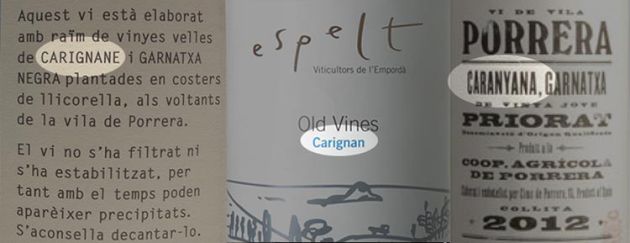
"Carinyena" sees the light of day
Carignan, Cariñena, Carinyena, Carignane, Caranyana, Mazuelo or Samso? Recent legislation in Spain has unravelled the convoluted issue of this grape’s myriad names
What current consumer perception that may exist of the Carignan grape is largely derived from wines that emerged from the "Wine Lake" in Southern France where large-scale winemaking took advantage of Carignan's key traits which is: massive yields. In its worst incarnation, it can produce some 20,000 l/ha but the tradeoff is then a weak, thin wine that's very acidity and tannic; hardly a welcoming profile.
While the grape is originally from Northeast Spain, it holds just over 6,000ha in total plantings for the country, 43% of which are in Catalonia. France has nine times this with over 53,000ha which why the French name became more widely-used in English as opposed to Mazuelo or Samsó that have historically been the only names in Spain legally allowed for use on labels.
It may seem a minor quibble, but it's been a major problem for winemakers in Catalonia where the traditional name has always been Carinyena. The president of DOQ Priorat, Sal·lustià Álvarez summed up the issue best, "When we buy the vines, they're called Carinyena. When we plant the vines and authorize the vineyards, they're called Carinyena. When we make the wines, all the paperwork says, Carinyena. But, when we go to label the bottles, this name is forbidden."
The issue to date has been DO Cariñena in Aragón who claim that to allow Carinyena (or the Spanish, Cariñena) on the label would confuse customers as it impinges upon their official region name. A "solution" was arrived at for Carignan where Catalan producers had the option of Samsó on the labels if they didn't want to use Mazuelo. The problem with this name (which is claimed to be an old synonym for Carignan) is that it sounds almost exactly the same at Cinsault which is a completely different grape in France.
So, the issue for Catalan producers was to either: use Samsó which no one has heard of or Mazuelo which is also relatively unknown given that it's a Central Spanish name and Carignan is a very minor grape next to the dominance of Tempranillo. The third option was to use the French, Carignan and risk the bad associations or confusion that might come along with that--if people even know the grape given that there is absolutely no AOP in France that permits varietal Carignan. French winemakers who believe in the grape have to label it "Vin de France" or under rare, general-unknown IGT classifications.
Those Catalan winemakers opposed to all the preceding options and who make small quantities have continued to use Carinyena on the label as they only sell locally. Others intentionally misspell it to read Caranyana which carries its own confusion. Needless to say, market fragmentation for Carignan in Catalonia has been the case for years now.
Thankfully, all this obfuscation has come to an end on October 29th with the release of the Spanish Official State Bulletin, BOE-A-2018-14803. In it, the use of both Cariñena and Carinyena are finally to be allowed. The reaction from Catalan winemakers has been near-universal as exclaimed by Josep Serra of La Vinyeta and Anna Espelt in DO Empordà who simply said, "Oh, what joy. Finally!" as they both have varietal Carignan projects to which they're finally able to give a universal name to legally.
Allowing unification behind a single name will now allow proper brand building within behind what has shown to be a vinous diamond in the rough. It's been shown via similar initiatives behind Carignan's typical blending partner, Grenache (Grenache Association, Grenache Day, Grenaches du Monde, etc.) that this works well to raise the profile of a well-made, yet often unknown grape to that of a fine wine grape.
Given the opposition from DO Cariñena for so many years, including putting out official statements reminding Catalan producers that they're forbidden to use the name, it's unclear as to what finally gave. When posed with the question, Salvador Puig the president of the Catalan wine authority, INCAVI stated, "To us, how we arrived here is less important than the fact that the name Carinyena is now finally available to Catalan wine producers. This is a wonderful event that's come to pass and we all hope it looks to a bright future for what is a very fine grape."
Keywords:
- wine
- Spain
- Legislation
- Catalonia
- Grape
- Catalan
- Carignan
- name
- Cariñena
- Carinyena
- Mazuelo
- Samso
- synonym




